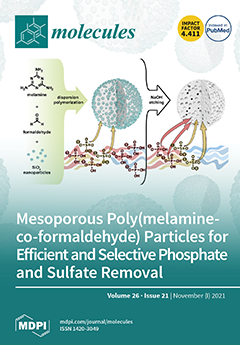Two hexanuclear paddlewheel-like clusters appending six carboxylic-acid pendants have been isolated with the inclusion of polar solvent guests: [Cu
6(Hmna)
6]·7DMF (
1·7DMF) and [Ag
6(Hmna)
6]·8DMSO (
2·8DMSO), where H
2mna = 2-mercaptonicotininc acid, DMF =
N,
N’-dimethylformamide, and DMSO = dimethyl sulfoxide. The solvated clusters, together with their fully desolvated forms
1 and
2, have been characterized by FTIR, UV–Vis diffuse reflectance spectroscopy, TG-DTA analysis, and DFT calculations. Crystal structures of two solvated clusters
1·7DMF and
2·8DMSO have been unambiguously determined by single-crystal X-ray diffraction analysis. Six carboxylic groups appended on the clusters trap solvent guests, DMF or DMSO, through H-bonds. As a result, alternately stacked lamellar architectures comprising of a paddlewheel cluster layer and H-bonded solvent layer are formed. Upon UV illumination (
λex = 365 nm), the solvated hexasilver(I) cluster
2·8DMSO gives intense greenish-yellow photoluminescence in the solid state (
λPL = 545 nm,
ΦPL = 0.17 at 298 K), whereas the solvated hexacopper(I) cluster
1·7DMF displays PL in the near-IR region (
λPL = 765 nm,
ΦPL = 0.38 at 298 K). Upon complete desolvation, a substantial bleach in the PL intensity (
ΦPL < 0.01) is observed. The desorption–sorption response was studied by the solid-state PL spectroscopy. Non-covalent interactions in the crystal including intermolecular H-bonds, CH⋯π interactions, and π⋯π stack were found to play decisive roles in the creation of the lamellar architectures, small-molecule trap-and-release behavior, and guest-induced luminescence enhancement.
Full article






